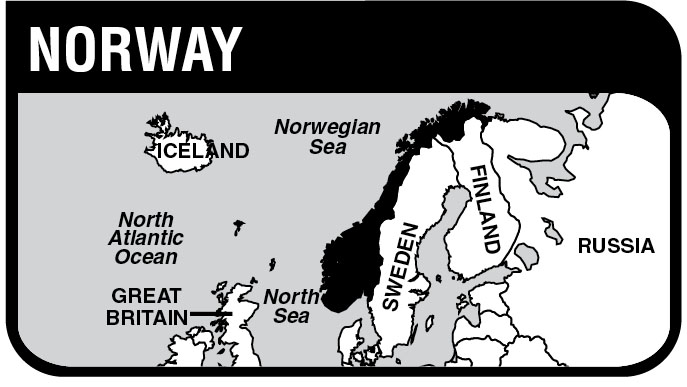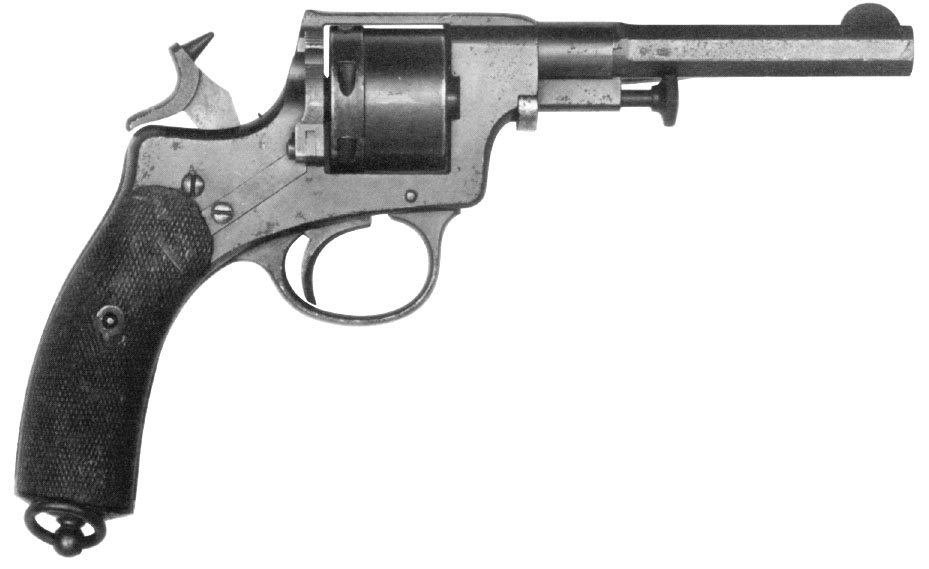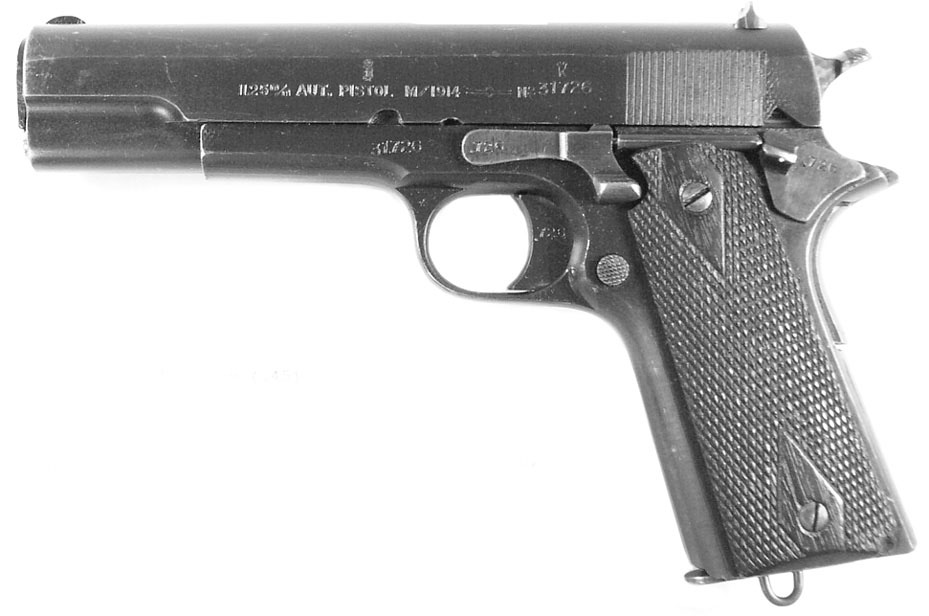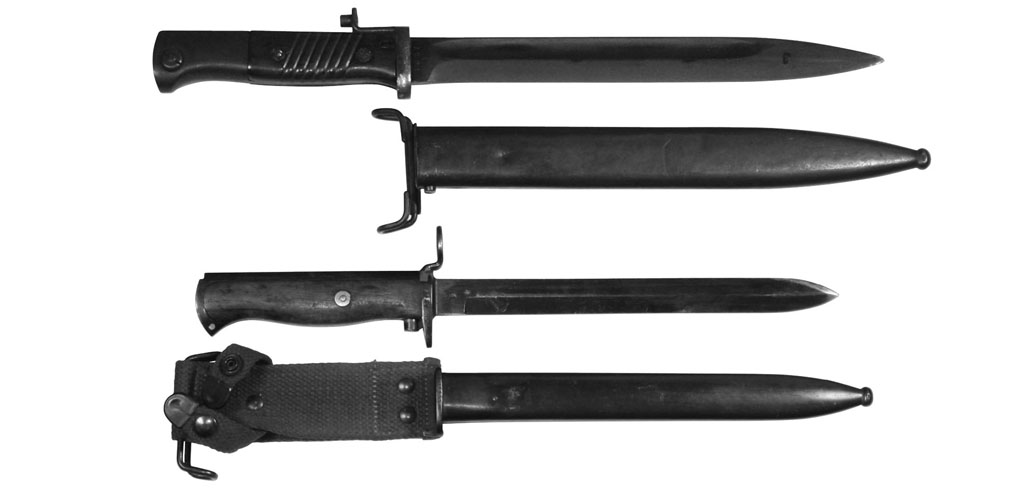

The Kingdom of Norway (Norge, Noreg), a constitutional monarchy located in northwestern Europe, has an area of 150,000sq. mi. (324,220 sq. km.), including the island territories of Spitzbergen (Svalbard) and Jan Mayen, and a population of *4.2 million. Capital: Oslo (Christiania). The diversified economic base of Norway includes shipping, fishing, forestry, agriculture, and manufacturing. Nonferrous metals, paper and paperboard, paper pulp, iron, steel and oil are exported.
A united Norwegian kingdom was established in the 9th century, the era of the indomitable Norse Vikings who ranged far and wide, visiting the coasts of northwestern Europe, the Mediterranean, Greenland and North America. In the 13th century the Norse kingdom was united briefly with Sweden, then passed through inheritance in 1380 to the rule of Denmark which was maintained until 1814. In 1814 Norway fell again under the rule of Sweden. The union lasted until 1905 when the Norwegian Parliament arranged a peaceful separation and invited a Danish prince (King Haakon VII) to ascend the throne of an independent Kingdom of Norway.
Model 1883 Revolver
Adopted in 1883, this Nagant six-round revolver has a solid frame with loading gate and mechanical rod ejection. Double action. Chambered for the 9×23R Belgian Nagant cartridge. Barrel is part round and part hexagon and is 5.5” long. Fluted cylinder and checkered wood grips with lanyard loop. Weight is about 32 oz. This model stayed in service until 1940. It was issued to both officers and NCOs.

Courtesy Geschichte und Technik der europaischen Militarrevolver, Journal-Verlag Schwend GmbH with permission
Exc. |
V.G. |
Good |
Fair |
1250 |
750 |
400 |
275 |
Model 1887/93 Revolver
Similar in appearance to the Model 1883 but chambered for the 7.5×22R Norwegian Nagant cartridge. Barrel length is 4.5”. Weight is about 28 oz. In service until 1940.

Courtesy Geschichte und Technik der europaischen Militarrevolver, Journal-Verlag Schwend GmbH with permission
Exc. |
V.G. |
Good |
Fair |
1250 |
750 |
400 |
275 |
Model 1912/14
All of the Model 1912/14 pistols were produced by the Norwegian arsenal at Kongsberg Vapenfabrikk. The official designation of the Norwegian Colt pistol was “COLT AUTOMATISK PISTOL, MODEL 1912, CAL. 11.43 M/M.” In 1917 the designation changed to “11.25 M/M AUTOMATISK PISTOL MODEL 1914.” The new marking began with serial number 96 (see Table 1). For a more detailed explanation of the differences in the Norwegian pistols see Clawson’s, Colt .45 Government Models, 1912 through 1970.
Kongsberg Vapenfabrikk Model M/1914 (Norwegian) copy SN 1-96
Rarely seen. Condition 99-100 percent add 20-30 percent.

Norwegian slide legend left side • Courtesy Karl Karash
Exc. |
V.G. |
Good |
Fair |
3500 |
2200 |
1150 |
850 |
Kongsberg Vapenfabrikk Model M/1914 (Norwegian) copy 29614 to 30536
Numbers must match.

Norwegian slide markings right side • Courtesy Karl Karash
Exc. |
V.G. |
Good |
Fair |
1400 |
900 |
750 |
600 |
Kongsberg Vapenfabrikk Model M/1914 (Norwegian) copy SN 29,615 to 30,535
Waffenamt marked on slide and barrel. Numbers must match. Waffenamt marked M/1914s outside this range are probably FAKES. Condition 99-100 percent add 20-30 percent.
Exc. |
V.G. |
Good |
Fair |
3000 |
1900 |
1150 |
850 |

Notice the extended slide stop on the left side • Courtesy Karl Karash

Norwegian slide legend left side with extended slide stop • Courtesy Karl Karash
TABLE 1
DATE |
SERIAL RANGE |
|---|---|
1917 |
1-95 |
1918 |
96-600 |
1919 |
601-1150 |
1920 |
1151-1650 |
1921 |
1651-2200 |
1922 |
2201-2950 |
1923 |
2951-4610 |
1924 |
4611-6700 |
1925 |
6701-8940 |
1926 |
8941-11820 |
1927 |
11821-15900 |
1928 |
15901-20100 |
1929 |
20101-21400 |
1932 |
21441-21940 |
1933 |
21941-22040 |
1934 |
22041-22141 |
1936 |
22142-22211 |
1939 |
22212-22311 |
1940 |
22312-22361 |
1941 |
22362-26460 |
1942 |
26461-29614 |
1945 |
29615-30535 |
1947 |
32336-32854 |
Norway used the German MP40, designated the M40, chambered for the 9×19mm Parabellum cartridge. The Norwegian military also issued the British Sten gun, as well as the HK MP5A2 and MP5A3. The Norwegian Marines use the Suomi 37/ 39 submachine gun.
The Norwegian military also uses the HK G3 rifle, the Mauser 98K converted to 7.62×51mm, as well as now-obsolete U.S. M1 Garands and U.S. M1 and M2 carbines.
Model 1842 Kammerlader Percussion Rifle
A unique breech-loading, percussion-fired rifle. Breechblock moves back and upwards by means of a lever on the right side. The hammer is on the underside, just in front of the trigger guard. The original caliber was 17.5mm, with later models being 11.8mm. Several variations were made including some carbines and long versions. Pricing on the U.S. market is about the same for all.

Courtesy Rock Island Auction Company
Exc. |
V.G. |
Good |
Fair |
3250 |
2500 |
1500 |
850 |
Model 1860 Rifle
A conversion of the Model 1842 to use a 12.2mm rimfire cartridge.
Exc. |
V.G. |
Good |
Fair |
2500 |
2000 |
1200 |
750 |
NOTE: See also U.S. Rifles, Remington, for Remington built rolling block rifles for Norway.
Model 1867 Rifle
Built in Norway by Christiana, Husqvarna, or Kongsberg. Fitted with a 37.3” barrel with three barrel bands and full length stock. Brass buttplate. Chambered for the 12.17×42R Norwegian Remington rimfire cartridge. Weight is about 10 lbs.
Exc. |
V.G. |
Good |
Fair |
850 |
650 |
500 |
300 |
Model 1889 Carbine
This model was essentially a Model 1867 fitted with a 24” barrel chambered for the 8×58R Danish Krag cartridge. Built at Kongsberg. Weight is about 8.5 lbs.
Exc. |
V.G. |
Good |
Fair |
1100 |
800 |
650 |
425 |
Kongsberg
Model 1880-1882 Experimental
In 1880-1882 about 500 Jarmanns were produced in Sweden for use in trials in Norway. This experimental model used a curved 5-round box magazine mounted from the top right side of the receiver forward of the bolt handle. Chambered for the 10.15×61Rmm cartridge and fitted with a 32” barrel. Marked with Carl Gustaf markings.
Exc. |
V.G. |
Good |
Fair |
Too |
Rare |
To |
Price |
Too Rare To Price
Model 1884 Rifle
Bolt action rifle with magazine tube under barrel with 8-round capacity. Chambered for the 10.15×61R Jarmann cartridge. Full stocked with two barrel bands. Fitted with a 32.5” barrel. Weight is about 10 lbs. These rifles made at Kongsberg and marked with a “K” on the receiver ring.
Exc. |
V.G. |
Good |
Fair |
Too |
Rare |
To |
Price |
NOTE: A carbine version was built but never adopted by Norway.
Model 1884/87
Similar to the Model 1884 but with recalibrated rear sight for smokeless powder.
Exc. |
V.G. |
Good |
Fair |
Too |
Rare |
To |
Price |
K98k Reissued Short Rifle (.30-06)
The only difference between this rifle and the standard issue German model is the markings. The Norwegian word “HAER” meaning “Army” is stamped on the receiver ring. A number of other stampings that denote Norwegian military organizations may also be seen, such as: HV=Home Guard; FLY=Air Force; KNM=Navy; K.ART=Coast Artillery; NSB=Government Railway; POLITI=Police.
Exc. |
V.G. |
Good |
Fair |
600 |
450 |
375 |
250 |
K98k Action Military Target Rifle (Model 59)
Exc. |
V.G. |
Good |
Fair |
700 |
600 |
500 |
275 |
Model 84S
This rifle uses a modified Mauser 98 military action with the original markings removed. Chambered for the 7.62mm NATO cartridge and first introduced in 1984. Built by Vapensmia A/S in Norway. Fitted with a heavy barrel by the German company Heym. Has a 5-round detachable magazine. Fitted with a 6×42 Schmidt & Bender scope. Adjustable trigger. Laminated birch stock. This rifle was also sold commercially.
Exc. |
V.G. |
Good |
Fair |
1500 |
1150 |
800 |
500 |
See also U.S., Rifles, Krag
NOTE: The Norwegian Krag rifles differ from the U.S. Krags primarily in that it does not have a cartridge cutoff. The Norwegian Krags were used by the Norwegian army as its principal long arm until the Germans occupied Norway in 1940. The majority of these rifles were built at Kongsberg, although some were produced at Steyr and FN Herstal. Norwegian Krags were chambered for the 6.5×55mm Swedish Mauser cartridge.
Model 1894 Rifle
This rifle is full stocked with pistol grip and full-length handguard. Barrel length is 30”. Box magazine is located in horizontal position and has a capacity of 5 rounds. Tangent rear sight. Weight is approximately 9 lbs.

Courtesy Paul S. Scarlata, Collecting Classic Bolt Action Military Rifles
Exc. |
V.G. |
Good |
Fair |
1000 |
850 |
750 |
400 |
Model 1895 Carbine
This model is half stocked with short handguard and fitted with a 20.5” barrel. Magazine capacity is 5 rounds. Weight is about 7.5 lbs. Very similar in appearance to the U.S. Krag carbine.

Courtesy Paul S. Scarlata, Collecting Classic Bolt Action Military Rifles
Exc. |
V.G. |
Good |
Fair |
1500 |
1100 |
800 |
400 |
Model 1897 Carbine
Similar to the Model 1895 carbine except the rear sling swivel is located near the toe of the buttstock.
Exc. |
V.G. |
Good |
Fair |
1500 |
1000 |
750 |
400 |
Model 1904 Carbine
This model has a 20.5” barrel with full stock and upper handguard but no bayonet lug. Weight is about 8.4 lbs. Estimated production is about 2,750.
Exc. |
V.G. |
Good |
Fair |
1600 |
1100 |
800 |
400 |
Model 1906 Boy’s Training Rifle
Introduced in 1906 for use at schools and shooting clubs. Chambered for the 6.5×55mm cartridge. Barrel length is about 20.5”. Weight is about 7.25 lbs. No upper handguard with shorter stock dimensions. Turned down bolt handle. One barrel band has front swivel. Estimated production is about 3,321. Rare.
Exc. |
V.G. |
Good |
Fair |
1800 |
1250 |
1000 |
500 |
Model 1907 Carbine
Similar to the Model 1907 but with sling swivels located on rear barrel band and buttstock.
Exc. |
V.G. |
Good |
Fair |
1500 |
1000 |
700 |
400 |
Model 1912 Carbine
Full stocked with 24” barrel and 5-round magazine. Fitted with a bayonet lug on nose cap. Weight is about 8.5 lbs. About 30,100 were produced.

Courtesy Paul S. Scarlata, Collecting Classic Bolt Action Military Rifles
Exc. |
V.G. |
Good |
Fair |
1200 |
800 |
500 |
300 |

Bayonets for Model 1912 Carbine
Bayonets for Norwegian Krag Jorgensen
Model 1894 Rifle
Wood grip. 8.3” single edge blade. Steel scabbard. Price range 175 – 100.
Model 1912 Carbine
Wood grip. 14.3” single edge blade. Leather scabbard. Price range 175 – 100.
Model 1923 Sniper
This model is fitted with a full stock and checkered pistol grip. Full-length handguard. Heavy barrel length is 26.2”. Bayonet fittings on nose cap. Micrometer rear sight with aperture. Marked “M.1894” on receiver. Magazine capacity is 5 rounds. Weight is about 9 lbs. Scarce with total production of about 630 rifles.

Courtesy Paul S. Scarlata, Collecting Classic Bolt Action Military Rifles
Exc. |
V.G. |
Good |
Fair |
4500 |
4000 |
3000 |
2000 |
Model 1925 Sniper
Fitted with a 30” heavy barrel similar to the Model 1894 rifle but with checkered pistol grip and micrometer rear peep sight. Weight is approximately 10 lbs. Scarce.
Exc. |
V.G. |
Good |
Fair |
4500 |
4000 |
3000 |
2000 |
Model 1930 Sniper
This model has a sporter-style half stock with checkered full pistol grip. Heavy 29.5” barrel. No bayonet fittings. Micrometer rear sight. Marked “M/1894/30.” Weight is approximately 11.5 lbs. Scarce.
Exc. |
V.G. |
Good |
Fair |
4500 |
4000 |
3000 |
2000 |
Norwegian Modified Bayonets for U.S. M-1 Garand and M-1 Carbine
Shown are a pair of interesting modifications Norway did to make bayonets for the rifles they received from the U.S. after WWII. The German 98K bayonet has a small stud added to fit into the M-1 Garand gas plug. Price range 175 – 75. The Norwegian 1894 Krag bayonet has an added muzzle ring to fit the M-1 Carbine. Price range 150 – 60.
Norway used the Hotchkiss machine gun, chambered for the 6.5mm cartridge, beginning in 1911, as well as the Model 1914 and Model 1918 Madsen guns. The Browning Model 1917 water-cooled gun was used by the Norwegians and designated the Model 29. After WWII the Norwegian military used the Browning Model 1919A4, as well as the MG 34 and MG 42. Currently Norway has adopted the MG 42/59 as its standard machine gun, designating it the LMG 3.

Norwegian Modified Bayonets for U.S. M-1 Garand and M-1 Carbine